Key takeaways:
- Fundamental analysis is essential for understanding the long-term value and potential of cryptocurrencies, beyond just price charts.
- Key metrics like market capitalization, trading volume, and tokenomics are crucial for informed investment decisions.
- Tools like news aggregators, blockchain explorers, and social media sentiment analysis aid in conducting thorough fundamental assessments.
- Lessons learned include the importance of long-term vision, awareness of community sentiment, and diversification of investment portfolios to mitigate risks.
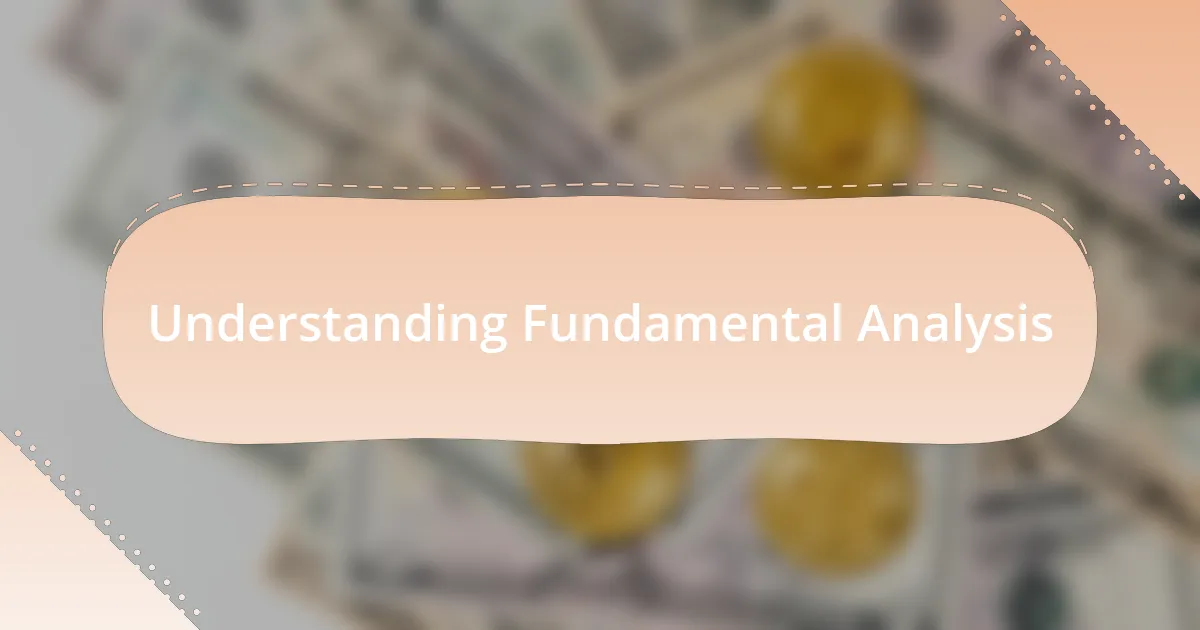
Understanding Fundamental Analysis
Fundamental analysis is essentially about understanding the underlying value of an asset, and it plays a crucial role in my cryptocurrency trading strategies. I remember vividly the first time I analyzed a cryptocurrency project deeply; it was quite an eye-opener. Instead of just looking at price charts and market trends, I began digging into the project’s vision, the team behind it, and its real-world utility. This made me realize that knowing a coin isn’t just about numbers; it’s about the story and potential behind it.
As I explored various cryptocurrencies, I often found myself asking, “What problem does this project aim to solve?” This question became a vital part of my analysis process. It helps me connect emotionally to the project while evaluating whether it’s positioned for long-term success. I truly believe understanding the purpose behind a cryptocurrency can provide a clearer picture of its future, making the investment decision more aligned with my values.
Additionally, watching how public sentiment and technological developments impact fundamental factors has been enlightening. For instance, during a bearish market, I recall staying up late to monitor community forums and social media channels. The insights I gathered about investor sentiment helped me feel more grounded in my investments. It’s fascinating how emotions, news, and project developments blend into the fundamental picture, illustrating why this analysis approach is indispensable for any serious cryptocurrency investor.
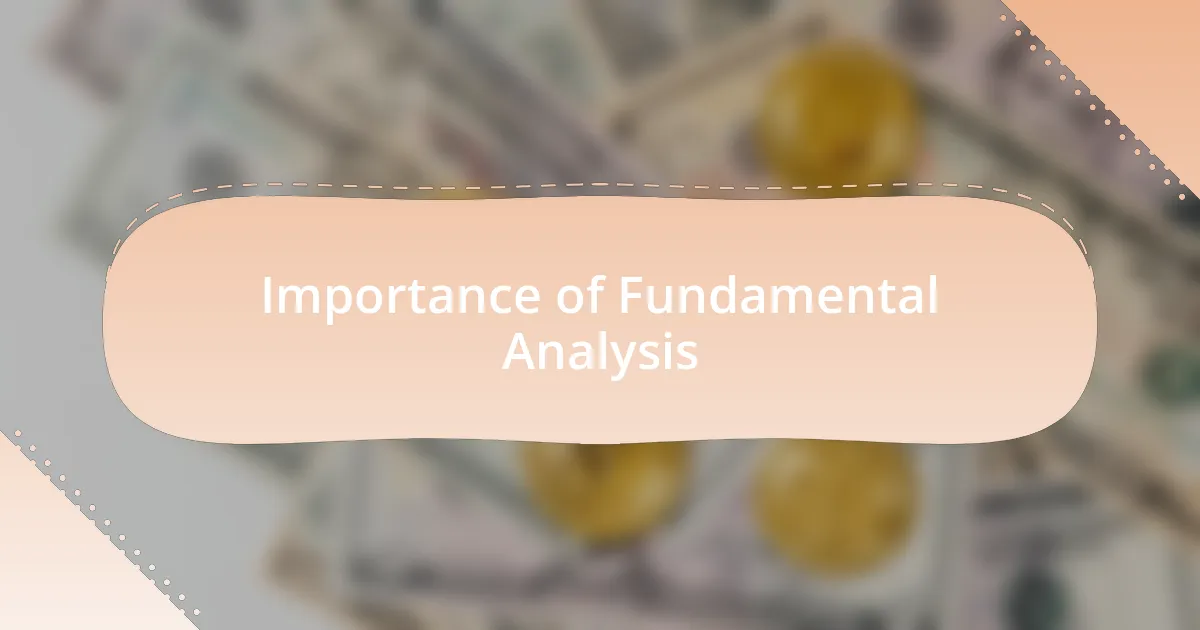
Importance of Fundamental Analysis
When I think about the importance of fundamental analysis, I can’t help but recall a time when I nearly made a hasty investment. I was excited about a newly launched coin, and the hype was palpable. But instead of diving into charts, I paused and researched the project’s whitepaper and community feedback. It hit me then—without understanding its fundamentals, I could easily jump on a bandwagon that might lead to a dead end. This experience solidified my belief that a solid grasp of the underlying value is essential to making informed decisions.
Engaging with the underlying fundamentals of a cryptocurrency doesn’t just guide my investments; it fuels my passion for the space. I often engage in discussions with fellow investors about project viability and innovation, and I find that those conversations are enriched by the depth of understanding I gain through my analysis. Have you ever noticed how talking with someone about a project can reveal insights you might have missed? That collaborative exploration elevates my perspective and highlights the truly impactful projects amidst the noise.
Additionally, I’ve found that keeping abreast of fundamental developments can serve as a shield against emotional volatility. There was a time when the price of a coin I believed in plummeted overnight. Instead of panicking, I recalled the team’s progress updates and the community’s ongoing support. This grounding in the core fundamentals kept me focused on the long-term vision, allowing me to withstand the market’s ebbs and flows. It’s a reminder that understanding the basics can provide a sense of stability in an otherwise unpredictable environment.
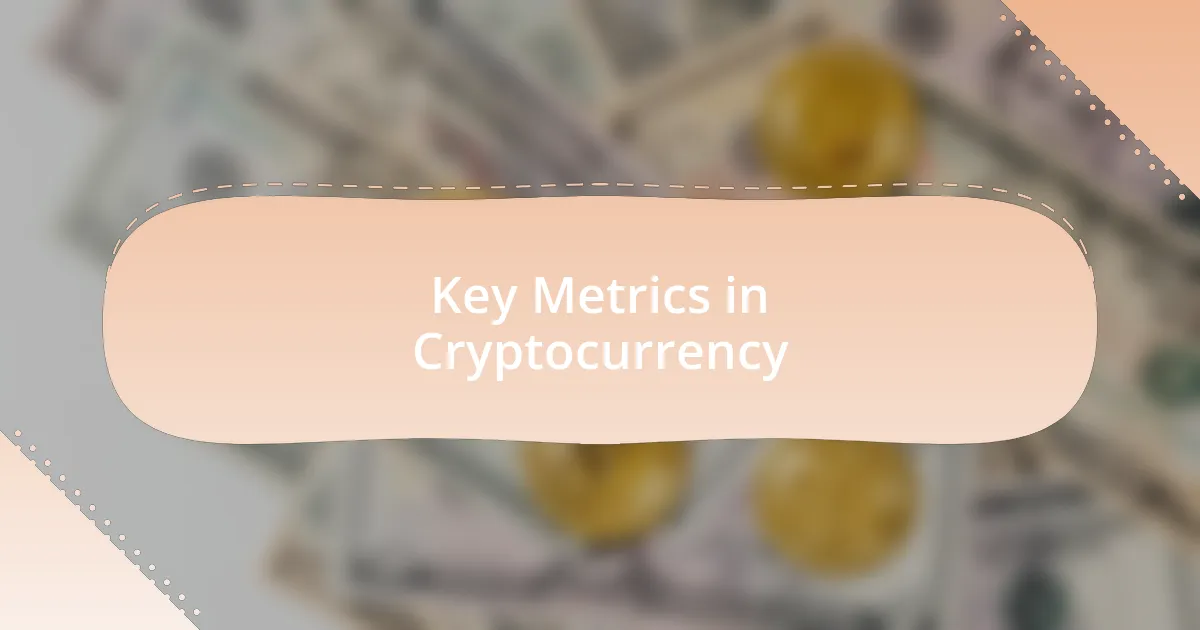
Key Metrics in Cryptocurrency
When assessing the key metrics in cryptocurrency, market capitalization often takes center stage. It’s essentially the total value of a cryptocurrency, calculated by multiplying its current price by the total supply. I remember analyzing a lesser-known cryptocurrency with a small market cap that seemed deceptively undervalued at first. It was a reminder that while a low market cap can signal growth potential, it also brings inherent risks and volatility that require careful consideration.
Another crucial metric I pay attention to is the trading volume. It serves as a gauge of market activity and liquidity; higher trading volumes typically indicate a strong interest in a particular cryptocurrency. I once witnessed a project with soaring trading volumes attract significant investor attention, encouraging me to delve deeper. I asked myself, what is driving this interest? Understanding these fluctuations allows me to distinguish between genuine momentum and fleeting hype.
The tokenomics of a cryptocurrency, or its economic model, is equally essential. This includes aspects like supply, distribution, and how tokens are utilized within a project. In one instance, I encountered a project that offered token staking rewards. After researching its tokenomics, I was drawn to its long-term vision. It made me think: how does the project incentivize real engagement from its community? Grasping the intricacies of tokenomics not only helps me make informed decisions but also fuels my enthusiasm for the potential of different projects.
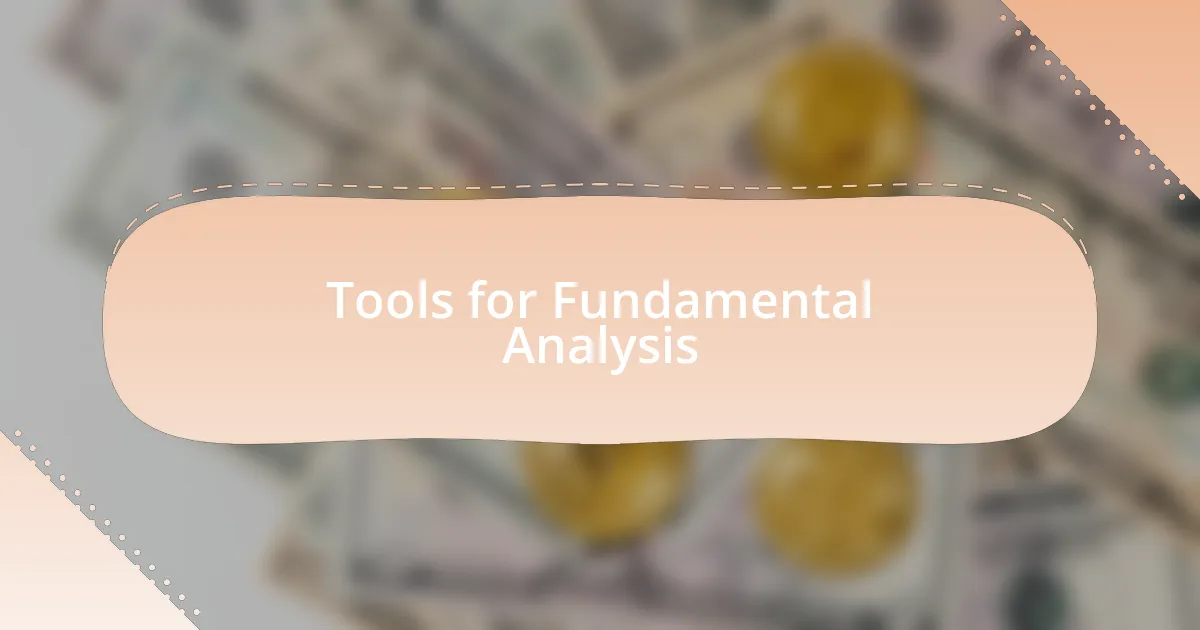
Tools for Fundamental Analysis
When it comes to tools for fundamental analysis, I rely heavily on cryptocurrency news aggregators and market analysis platforms. These platforms provide a wealth of information at my fingertips, enabling me to stay updated on real-time developments that can affect a cryptocurrency’s price. I vividly remember discovering a major partnership announcement through one of these aggregators that sent the price of a coin skyrocketing. It hit me then how crucial timely information is in this fast-paced market.
Another indispensable tool in my analysis toolkit is blockchain explorers. They give me insights into a cryptocurrency’s transactions and overall network health. I once used a blockchain explorer to track the activity of a particular token, and I was astounded by the number of transactions happening daily. This knowledge made me reflect on the project’s usage and community engagement, prompting me to dive deeper into its long-term viability.
Social media sentiment analysis tools have also proven invaluable in gauging community sentiment around a cryptocurrency. I remember participating in a discussion on a popular forum where the community was buzzing about a new project. By analyzing these discussions and the prevailing sentiment, I was able to anticipate market movements and make informed investment decisions. It was a reminder that often, emotion and community perception play powerful roles in the cryptocurrency landscape.
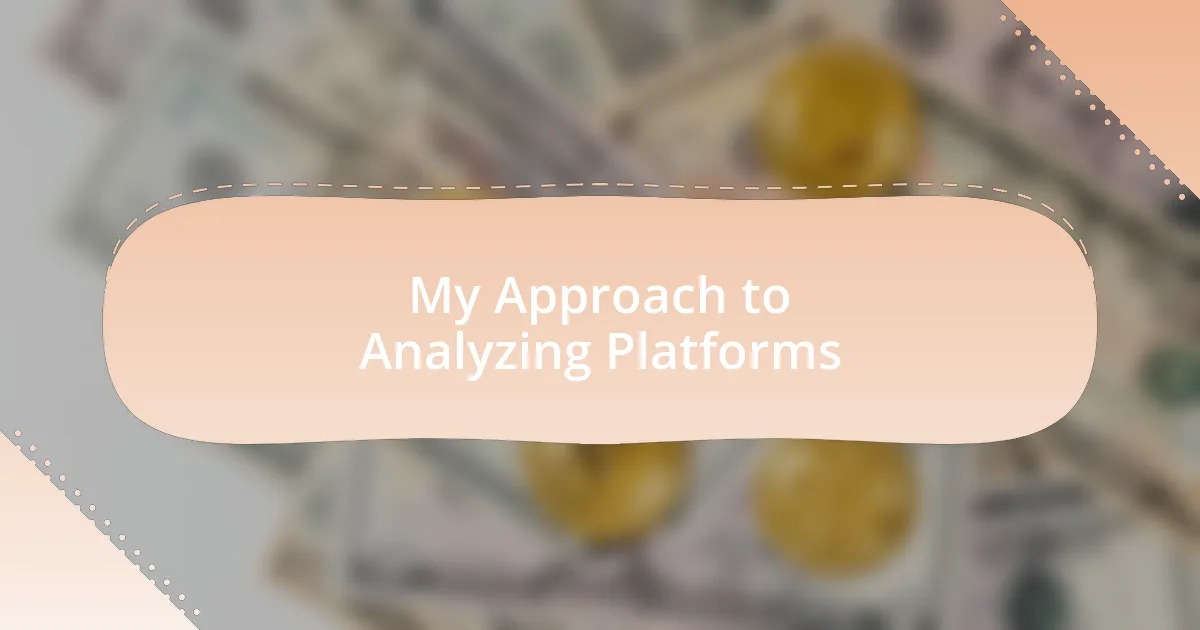
My Approach to Analyzing Platforms
When I analyze cryptocurrency platforms, I start by delving into their underlying technology. I often find myself asking, “How does this technology stand out from its competitors?” For instance, I remember studying a platform that utilized a unique consensus mechanism. This exploration revealed not only its potential for scalability but also helped me gauge whether it could outperform traditional systems. Understanding these technological nuances fuels my confidence in a platform’s long-term success.
Next, I turn my attention to the team behind the project. I look for leaders with a proven track record, asking myself, “Have they successfully launched projects before, and do they have a vision for the future?” A while back, I was drawn to a relatively new platform because of its experienced founders. This deepened my enthusiasm as I learned about their previous successes, which reassured me they had both experience and a genuine commitment to the project. Knowing the team’s capability often influences my willingness to invest.
Finally, I embrace industry trends by exploring market positioning and competition. It’s essential to ask, “Where does this platform fit in the evolving landscape?” I vividly recall a moment of realization when I compared two competing platforms, discovering one was swiftly gaining ground due to strategic partnerships. This insight pushed me to reconsider my investment approach and highlighted the importance of adaptability in a dynamic market. By consistently evaluating these factors, I feel more equipped to make informed decisions in my cryptocurrency investing journey.

Case Studies of Successful Platforms
One case study that stands out to me is Binance. When I first dug into its rapid growth, I was genuinely intrigued by how it launched diverse products quickly, appealing to a broad audience. I often wondered, “What set Binance apart during its early days?” Through my analysis, I discovered a combination of extensive user engagement and innovative features that addressed traders’ needs in real-time, giving it an edge over competitors.
Another impressive example is Coinbase. As I explored its journey, I noted that its robust regulatory compliance played a pivotal role in gaining investor trust. I can recall my hesitation during the regulatory scrutiny of many platforms, yet Coinbase’s proactive stance reassured me. This highlights how a platform’s commitment to following legal standards not only fortifies its operations but builds confidence among users, which is crucial for long-term success.
Then there’s Kraken, which I had followed closely during a significant market downturn. I remember feeling anxiety at the time, but I was amazed by how Kraken managed to maintain user trust through transparent communications about outage issues. I couldn’t help but think, “How do some platforms navigate crises better than others?” This experience underscored the importance of reliability and communication in the cryptocurrency space, reinforcing my belief in Kraken’s resilience and long-term viability.

Lessons Learned from My Experience
As I immersed myself in fundamental analysis, one key lesson I learned was the importance of long-term vision. I remember getting swept up in the hype of short-term price swings and feeling a rush of excitement. Reflecting on those moments, I realized that understanding the underlying technology and potential of a cryptocurrency is far more rewarding than chasing fleeting trends. It’s like planting a seed; nurturing it with knowledge ensures it grows strong.
Another lesson hit home when I assessed the impact of community sentiment. I vividly recall watching a promising project lose traction due to negative news. This experience made me recognize how powerfully emotions drive market behavior. I now approach sentiment analysis with caution, understanding that navigating the emotional tides of investors can often reveal hidden opportunities.
Lastly, I learned that diversifying my investment portfolio is paramount. Early on, I overly concentrated on a few cryptocurrencies, only to face anxiety during market corrections. Through that experience, I understood that spreading my investments across diverse assets not only reduces risk but also opens doors to new growth avenues. It’s a strategy I now apply rigorously, reminding myself that variety isn’t just the spice of life; it’s a crucial element in successful investing.